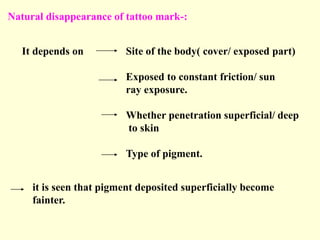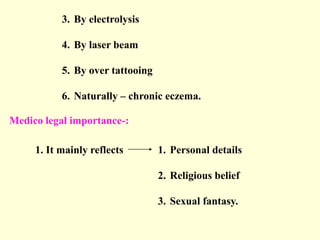stature.ppt
- 1. Stature Definition-: it is the body length of a person. Variation- 1. Maximum 1. Age between 20 to 25 years 2. During morning 3. Recumbent position 4. Dead body ( primary relaxation) 2. Minimum 1. After 25 years 2. During evening 3. Standing 4. Dead body (rigor mortis ) Variation is due to intervertebral elasticity, reduced muscular tone, relaxation of joints.
- 2. Estimation of stature-: 1. Complete body 2. Incomplete body (dismembered body parts) 3. Skeleton- complete 4. Incomplete skeleton 1. Complete body Heel -------------------- Vertex 2. Dismembered or mutilated body parts Depending on the availability a) Heel to Pubis = ½ of the stature b) Vertex to pubis = ½ of the stature
- 3. c) Length between two middle finger tips in full extended position = stature. d) Suprasternal notch to Pubic symphasis multiply into 3.3 e) Length of one arm multiply into 2 + 34cm f) Vertex to chin multiply into 8 3. Complete skeleton available- Length of entire skeleton (Toe to Vertex) + 2.5 to 4 cm
- 4. 4. Incomplete skeleton a) If only vertebral column Full length 100 / 34 b) If only long bones are available- then it is easy to calculate by using some National , International formulae. International-: 1. KARL PEARSONS FORMULA 2. TROTTER & GLESSERS FORMULA National -: PAN---- Bengal, Bihar, Orissa NAT----- U.P SIDDIQUE& SHAH--- Punjab
- 5. Principle of formulae-: Length of long bone Multiplying factor (for each bone) + Constant factor It is measured by Hepburn Osteometric board The constant factor & multiplying factor are different for different sex, race, dry or wet state of Bone. Formula for stature are not valid for children, giant, dwarf people.
- 7. Dactylography Dactyloscopy Dermatoglyphics Henry Galton system Synonym: History -: Sir William Herschel – ICS –Hooghly Dist. (W.B) used finger prints in official document.(1858) Sir Francis Galton (anthropologist) worked on the Science of fingerprints & published a book on it. (1890)
- 8. Sir Edward Richard Henry (I.G) improved this system further and applied in the field of identification.(1890) The first fingerprint bureau in the world was officially established in Calcutta 1897 It is officially accepted in all over the world by 1908. Definition. It is the study of the impression of patterns formed by the papillary ridges on the bulbs of fingers.
- 9. Developed in intrauterine life and remain unchanged No two fingerprints are identical Can be taken from decomposed body it follow Quetelets Rule Advantage of fingerprint It state that every nature made objects shows infinite variation of forms and in the world’s crime records no two identical fingerprint patterns have been reported.
- 10. Classification-: Primarily (a)Arches: 7% 1. Plain arch 2. Tented arch 3. Exceptional (b) Loops: 65% 1. Radial 2. Ulnar loops (c) Whorls : 25% 1. Concentric 2. Spiral 3. Double spiral 4. Almond shaped (d) Composite: 2-3% 1. Central pocket loop 2. lateral pocket loop 3. twinned loops 4. accidental
- 12. But a considerable finer details of branching, sub-branching & coalescence of ridges, Islands, Core, Delta arrangement absolutely great help in proper identification. Individuality of fingerprint-: No two fingerprints are alike & identical Chances of similarity 1 in 64, 000 millions. Fingerprints pattern are not inherited. In practice, 16 to 20 points of fine comparison are accepted as proof of identity.
- 14. Types of Fingerprints at the scene of crime Visible Fingerprint: Finger contaminated with blood, paints, dyes etc touches something Plastic Fingerprint: Fingerprint left on soft materials like wax, soap, dust etc. Latent Fingerprint: Impression is not usually visible Made visible by chemical reagent Latent Fingerprint Recorded by photograph / Lifted by using adhesive cellophane paper
- 15. Latent fingerprint The chemical used are powdered graphite, Mgco3, white lead, red lead, antimony.
- 16. Plain method Type of Finger impression-: Rolled Method Just pressing the inked Ball of the finger on the Paper. Pressing the finger ball of the finger on the paper with rolled one side to other. It is better as it gives wider & it offers better study of pattern of ridges.
- 17. Mode of taking finger impression-: Hand washed clearly & thoroughly. Prints is taken by using printers ink on an unglazed white Paper. Fingerprints should not be taken-: Leprosy Scars on hand Electrical injury Coeliac disease Eczema Ricket Acromegaly Acanthosis Nigrican
- 18. Medico legal importance-: 100% accurate in establishing identity Finger print experts can render a faint and invisible print By using the chemical like Aluminum hydroxide. Fingerprints from dead unknown body– prints of all 10 digit Shrinked dead body– soak the finger tips with alkaline solution & then take the print. In degloving skin– take the print of dermis:
- 19. To identify chance impression of criminal left at the scene of Crime To maintain identity records of habitual offender It is the signature of illiterate( left thumb impression) If the person is right handed. For prevention of impersonation For prevention of accidental exchange of newborn
- 24. Scar Introduction-: Scar or cicatrix is a fibrous tissue covered by epithelium formed as result of healing process of a wound. It is devoid of hair follicle, pigments, & sweat gland. Scar being formed of fibrous tissue with less vascularity resists decomposition that helps in identification in grossly decomposed body Best known case identified --- Crippen case in 1910.
- 25. Examination of scar-: must examined under adequate light. description should contain the no, site, size, shape, fixed or mobile, presence or absence of tenderness and color. for faint scar make it properly visible By 1. applications of heat. 2. Filtered U.V light 3. Surface friction.
- 26. Shape of scar-: a scar generally assumes the shape of the wound causing it. incised wound-------- linear & straight scar lacerated wound-------- irregular & large scar stab wound------------- elliptical & irregular scar Vaccination scar--------- oval scar. age of scar-: it is difficult to asses the exact age of a scar as it varies 1. The nature, size & position of the wound
- 27. 2. Presence and absence of infection. 3. Method of healing 4. Age of the person 5. Health status of the person. An uninfected superficial cut almost heels by 5 to 6 days. Fresh scar (1 to 2 wk) Soft, tender, sensitive, Reddish ( angry looking)
- 28. Recent ( 2 to 3 months ) soft, coppery or pale, tender Without any contracture. Late (3 to 6 months) Tough, white color Without contracture. Old ( 6 months to yrs) Tough, white color Glistening With contracture. Disappearance of scar-: Whole thickness scar always permanent It may removed by plastic surgery.
- 29. Medico legal importance of scar-: Identification of the individual Identification of the causative weapon / agent Age of injury Stria Gravidarum Old scar on wrist/ throat Scar on face Indicates previous pregnancy Indicates previous attempt of suicide. Grievous hurt.
- 30. Scar on cubital fossa or dorsum of hand indicates drug addiction. Vaccination marks and pock marks though scar, cannot be used as identification mark because of their common appearance in many people. A keloid resulting from scar cannot be an identification mark as it may changes in shape & size.
- 32. Tattoo mark Ta tau– to mark These are the design or imprint produced in the skin by multiple punctured wounds by the needle dipped in some coloring material. Tattooing is not seen in Beduin, Arabian & Muslims. Commonly seen in Illiterate, low socio economic peoples criminals and in Prostitute.
- 33. Coloring material-: Black - carbon dust Blue black – Indian ink Blue – Prussian blue Red -- ultramarine Brown -- Ochre Green -- chromic oxide White -- titanium oxide.
- 34. Natural disappearance of tattoo mark-: It depends on Site of the body( cover/ exposed part) Exposed to constant friction/ sun ray exposure. Whether penetration superficial/ deep to skin Type of pigment. it is seen that pigment deposited superficially become fainter.
- 35. When dye or the pigments disappeared from the skin they may be demonstrable in the regional lymph node. Revealing latent tattoo mark-: 1. Application of heat, rubbing, U.V light then magnifying lenses. 2. Infrared photography. Artificial removal of tattoo mark-: 1. Surgically 2. Burning Excision & skin grafting, Scarification, Heat or chemical burn.
- 36. 3. By electrolysis 4. By laser beam 5. By over tattooing 6. Naturally – chronic eczema. Medico legal importance-: 1. It mainly reflects 1. Personal details 2. Religious belief 3. Sexual fantasy.
- 37. 2. Drug addicts especially the I.V drug abuser may conceal the site of injection by a tattoo design. 3. It also indicates the mental make up, desires and behavioral characteristics. Erotic tattoo mark– sexual fantasy. Blue bird design on between thumb & index fingers Homosexual
- 41. Complication of tattooing-: 1. Inflammation & sepsis 2. Abscess 3. Gangrene 4. Tuberculosis 5. Leprosy 6. Syphilis 7. AIDS Involuntary tattooing-: Tattoo mark resulted from impregnation of un burnt and partially burnt gun powder around the main gun shot wound of entrance.









































